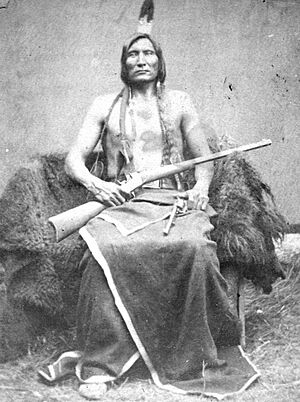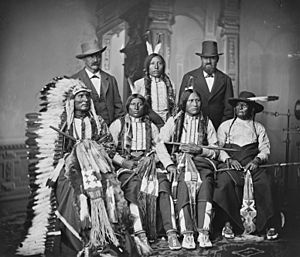Touch the Clouds facts for kids
Quick facts for kids Touch the Clouds |
|
|---|---|
| Minneconjou headman | |

By James H. Hamilton, taken at the Spotted Tail Agency, Nebraska, in the fall of 1877
|
|
| Successor | Amos Charging First |
| Born | c. 1838 Great Sioux Nation |
| Died | September 5, 1905 (aged 66–67) Cheyenne Riverside Indian Reservation, South Dakota |
| Spouse | Spotted on the Ground |
| Father | Lone Horn |
| Mother | Stands on the Ground |
Touch the Clouds (whose name in Lakota was Maȟpíya Ičáȟtagya or Maȟpíya Íyapat'o) was an important leader of the Minneconjou Teton Lakota (also known as Sioux) from around 1838 to September 5, 1905. He was known for being brave, strong, and good at making peace. He was the youngest son of a respected leader named Lone Horn. Touch the Clouds was also the brother of Spotted Elk and Roman Nose. Some people believe he was a cousin to Crazy Horse, another famous Lakota leader.
When his group, the Wakpokinyan band, divided in the mid-1870s, Touch the Clouds led part of them to the Cheyenne River Agency. He became the main leader of his people in 1875 after his father passed away. He continued to lead them during the early parts of a big conflict known as the Great Sioux War of 1876-77. After the Battle of the Little Bighorn, he guided his group north. Eventually, he and his people joined the Spotted Tail Agency, where he even became an Indian Scout. Later, after being present when Crazy Horse died, Touch the Clouds and his group moved back to the Cheyenne River Agency.
Touch the Clouds became one of the main leaders of the Minneconjou at the Cheyenne River Agency in 1881. He held this important position until he passed away on September 5, 1905. His son, Amos Charging First, then became the new chief.
Contents
A Strong Leader: Touch the Clouds
Early Life and Becoming a Chief
Touch the Clouds was born around 1837 to 1839. He was the youngest son of a very important leader named Lone Horn. Lone Horn led a Minneconjou group called the Wakpokinyan, which means "Flies Along the Stream." Touch the Clouds was famous for being very tall and strong. His name even came from his impressive size. A soldier named Lieutenant Henry R. Lemly met him in 1877. He said Touch the Clouds was "magnificent" and stood 6 feet 9 inches tall, weighing 300 pounds.
As Touch the Clouds grew older, he earned the respect of his people. By his thirties, he was chosen to lead one of the tribe's warrior societies. In this role, he often led groups to protect his people or to gather horses from other tribes. For example, in 1872, White Bull remembered when Touch the Clouds led a group to get horses. They decided to turn back when they saw too many Crow warriors.
During this time, more and more European-Americans were moving onto the Great Plains. This caused disagreements among the different Lakota groups about what they should do. Touch the Clouds' group, the Wakpokinyan, seemed to divide. Part of the group, including Touch the Clouds, went to the Cheyenne River Agency near the Missouri River. Another part, led by Lame Deer, chose to stay away from the agencies. His father, Lone Horn, worked hard to keep everyone talking and to find peaceful solutions. He was known as a great Lakota diplomat. After Lone Horn passed away in 1875, Touch the Clouds became the new leader. This happened just as the US Army began to move against some Cheyenne and Lakota groups who had not signed agreements.
Times of Conflict: The Great Sioux War
At the start of the Great Sioux War of 1876-77, Touch the Clouds stayed with his group at the Cheyenne River Agency. After news reached them about Custer's defeat at the Little Bighorn, Touch the Clouds spoke to army officers. He asked them to "Have compassion on us. Don't punish us all because some of us fought when we had to." The army thought that groups at the agencies were helping the "hostiles." So, they planned to take away the weapons and horses from the friendly Lakota. In late September 1876, Touch the Clouds suspected the army's plans. He led many Minneconjou and Sans Arc people away from the agency. They left their belongings behind in their quick journey north.
Seeking Peace and Surrender
When these groups, including Touch the Clouds, Roman Nose, Bull Eagle, and Spotted Elk, arrived in the north, they brought a more peaceful approach to the leaders there. In October 1876, the combined Native American forces had several small fights with soldiers. After Crazy Horse and Sitting Bull left with their groups, Minneconjou leaders met with Colonel Nelson Miles. They talked about the possibility of joining an agency. By February 1877, Touch the Clouds was camped with about 60 or 70 lodges near the Little Missouri River. Here, he met the famous Brulé leader, Spotted Tail, for a five-day discussion. He agreed to take his group to the Spotted Tail Agency in northwestern Nebraska. They arrived on April 14, 1877. Touch the Clouds was the first to ride forward. He announced, "I lay down this gun as a sign of joining Gen. Crook, to whom I wish to join."

A Time of Change: Crazy Horse and Delegates
For the next few months, Touch the Clouds and the Minneconjou lived peacefully at the Spotted Tail agency. Louis Bordeaux, an interpreter there, described Touch the Clouds as "an honorable and peaceable Indian, a man of good character, a very fine man, disliked fighting and was a peacemaker." The army asked him to join the Indian Scouts, and Touch the Clouds became a first sergeant.
Touch the Clouds' relationship with army officials became difficult in late August 1877. He and Crazy Horse were asked to lead scouts north to fight Chief Joseph and the Nez Perce. Four days later, the army tried to arrest Crazy Horse. He managed to get away to the Spotted Tail Agency. Touch the Clouds went with his friend back to Camp Robinson. There, Crazy Horse passed away after an incident with army soldiers who were trying to hold him. Touch the Clouds was allowed to stay with Crazy Horse that night until he died. Placing his hand on Crazy Horse's chest, Touch the Clouds said, "It is good: he has looked for death, and it has come." The next month, Touch the Clouds traveled to Washington, D.C. as a delegate.
In October 1877, the Red Cloud and Spotted Tail Agencies moved to the Missouri River. During this time, Touch the Clouds and his group joined the Oglala. Many of the northern groups who had joined agencies earlier that spring left. They went north to join Sitting Bull in Canada. Touch the Clouds was able to keep most of his group calm and prevent them from leaving. He asked that they be moved back home to the Cheyenne River Agency. Dr. James Irwin, the agent at Red Cloud, supported this move. He noted that Touch the Clouds had been "very obedient and orderly during his stay with me and with his band remained behind when all the others left here."
Life at Cheyenne River Reservation
Touch the Clouds and his group finally returned in February 1878 to the Cheyenne River Reservation in central South Dakota. He lived there for the rest of his life. By the spring of 1882, the last remaining Minneconjou groups had returned to Cheyenne River. This brought the tribe together for the first time in many years. By this time, only three of the tribe's traditional six headmen were still alive. In 1882, the Minneconjou either confirmed or chose new leaders to fill these open spots. Touch the Clouds was confirmed as a "shirt wearer," taking his late father's place. Other new leaders chosen included White Bull, Big Crow, White Swan, and Touch the Bear. At the ceremony, the new leaders sang a song that said: "It is hard to be chief; But I do my best to be a chief."
In 1898, Touch the Clouds traveled to Omaha, Nebraska. He was part of the Trans-Mississippi and International Exposition, where he was photographed by Frank A. Rinehart.
Legacy of a Peacemaker
Touch the Clouds continued to speak up strongly for his people for the rest of his life. In 1884, Rev. Addison Foster visited the Cheyenne River Reservation. After a church service, Touch the Clouds stayed behind. He said that he understood the importance of this new way of life. He also wished for schools and churches for himself and his people. He passed away on September 5, 1905, near the Cherry Creek River in South Dakota.
Touch the Clouds was married at least twice. He had several daughters and at least one son. His oldest son, Amos Charging First, became a community leader after his father. He continued the family line of Minneconjou leaders that began with the great Lone Horn.


